
When it comes to being sick, the last place most people want to be is at work performing our day-to-day duties. For me personally, I like to rest in bed or possibly nurse a respiratory infection with a warm bowl of chicken noodle soup. Unfortunately, the reality is whether resting at home or trying to get by at work, there is a cost associated with being sick. In this blog I will dive into some of the effects illness has on the workplace and provide solutions to help prevent the spread of illness-causing germs.
The Average Adult Gets Sick 3 Times a Year1
Although we typically think of the winter months as the time for illness, and while cases may increase during this period, germs can spread and cause sickness throughout the year. The result of illness from these germs could range from symptoms as mild as the sniffles to severe infection, which may lead to hospitalization. In all cases, there is the potential that germs from a sick person be spread and transmitted to others. With the average adult experiencing multiple illnesses each year1, it is possible that their infection may have been due to exposure to illness-causing viruses and bacteria at the workplace. Once ill, they may even contribute to the spread of germs at work, infecting more coworkers in the process.
9 in 10 U.S. Workers Say They Worked When Sick Over the Past 12 Months2
Employees often continue to come into work when sick for various personal and employment-related reasons. While the intent of this blog is not to focus on these, I do want to point out that coming to work sick has a cost, also known as presenteeism. This term refers to the loss of productivity when employees are not fully functioning in the workplace. According to the Harvard Business Review, U.S employees working while sick costs employers an estimated $150 billion to $250 billion each year.3 This is equivalent to 60% of the total cost of worker illness.3
Another important drawback of working when sick is the potential spread of illness-causing germs in work settings. Research conducted by the University of Arizona found when one sick employee spends just two to four hours in the workplace, they have the potential of spreading germs to more than 50% of commonly touched surfaces in the area.4 Germs spread easily in work settings, which increases the risk of other employees being exposed and potentially getting sick. A recent CloroxPro study found that facility disruptions such as employee absences and having to close offices are a top concern for offices and Building Service Contractors (BSC).5
Illness-related Absences Are Not Cheap
As important as it is to remain home to rest and recover during times of sickness, workplace absences impact employers. Just as presenteeism results in loss of productivity, so do absences. In the United States each year productivity losses linked to absenteeism cost employers $225.8 billion or $1,685 per employee.3 While absenteeism may look different business to business, the fact remains that absent employees due to sickness costs money and takes a toll in countless ways. To better understand how absenteeism may affect your business, follow this link to an Office Absenteeism Calculator.
Helping to Keep Employees Healthy Is the Best Policy
While there is no perfect fix to keep sick staff members from coming to the office or missing work, and each comes at a cost, there are solutions to help prevent the spread of illness-causing germs, thereby helping protect employees from becoming sick. This is achieved through regular cleaning and disinfection of commonly touched surfaces and shared spaces. To help prevent the spread of germs throughout the day consider the following:
- Use disinfectant wipes as a convenient, time-saving solution in commonly shared spaces like a lobby or conference room.
- Cleaning professionals and office occupants should partner to perform cleaning and disinfecting on shared, frequently touched surfaces.
- Focus on cleaning and disinfection during moments that matter, like the start of the workday, to help keep the workplace safe and achieve cleanliness in spaces year-round.
- Check out this Office Wellness Toolkit for additional information on preventing the spread of germs in the office.
References
1. Melore C. Average Adult Gets Sick 3 Times Each Year, and Spouses are ‘Most Annoying’ Patients [Internet]. Studyfinds.org. 2022 [cited 2024 Jan 9]. Available from: https://studyfinds.org/average-person-sick-3-times-year/
2. BambooHR. Guilty Until Proven Sick: Why US Workers Don’t Take Sick Leave (2023 Data) [Internet]. [cited 2024 Jan 9]. Available from: https://www.bamboohr.com/resources/guides/sick-guilt-2023
3. CDC Foundation. Worker Illness and Injury Costs U.S. Employers $225.8 Billion Annually [Internet]. [cited 2024 Jan 9]. Available from: https://www.cdcfoundation.org/pr/2015/worker-illness-and-injury-costs-us-employers-225-billion-annually
4. University of Arizona News. Germs Spread Fast at Work, Study Finds [Internet]. 2013 [cited 2024 Jan 9]. Available from: https://news.arizona.edu/story/germs-spread-fast-at-work-study-finds
5. CloroxPro. 2023 Clean Index Study. Data for this report was collected in Spring 2023 an online survey of a nationally representative U.S. General Population based on age, gender, region, race/ethnicity and income and cleaning industry professionals defined as business service contractors, facility managers in education, commercial buildings, and healthcare facilities.
Jordan Bastian, a Senior Infection Preventionist within CloroxPro's Clinical and Scientific Affairs team, recently sat down with Dr. Saskia Popescu, Assistant Professor, Epidemiologist and CloroxPro Spokesperson, to discuss their predictions for the 2023-2024 cold and flu season. Check out the video above or keep reading below to hear their thoughts on what's to come and what precautions we can take to help stop the spread of illness-causing germs.
Please note this is an abridged version of the conversation edited for brevity and clarity.
Jordan Bastian: Hi, I'm Jordan Bastian, Senior Infection Preventionist with Clorox Pro. With me today, I have Saskia Popescu, Assistant Professor and Epidemiologist and CloroxPro Partner, to discuss predictions and best practices to help prevent the spread of illness-causing germs this cold and flu season.
Saskia Popescu: Thanks so much, Jordan. I'm so excited to chat with you today.
Jordan Bastian: So, to kick it off today, I'd love to pick your brain on what you think cold and flu season will look like this year in the United States based on current data and trends.
Saskia Popescu: I think we're likely in for a moderate flu season. We're getting some really helpful information out of Australia as they're currently heading into their summer, which means they've already experienced their flu season, and what we actually get to see is their experiences through that as a way to predict our own.
Australians reported that they had a moderate flu season that started a little bit later. They still had surges and spikes, but nowhere near the severity of the 2016 and 2017 flu seasons. So, most likely, what we're going to experience is a moderate flu season with later activity, looking more toward the kind of pre-covid seasonal patterns.
Jordan Bastian: RSV is another pathogen to keep our eyes on. As you mentioned, Saskia, in the southern hemisphere, what we're seeing out of Australia is they had an uptick in RSV cases, which might signal that we might be seeing some increased cases of RSV as well. Australia also saw that 72% of hospitalizations due to cold and flu or respiratory illness were in children 16 and under, and this was up 24% from last year.
A lot of this has to do with behavior changes as well as relaxed precautions. We know more people are traveling now. We're also seeing more kids returning to school, as well as employees who have been working remotely, spending more time in the office. We also see lower vaccination rates due to vaccine fatigue and hesitancy. Last year, respiratory illness rates were as high as 16%. What I'd like to know now is what some of these best practices are that we could put into place to help protect us and slow the spread of these illness-causing germs.
Saskia Popescu: That's a great question. In addition to ensuring you get your flu shot, we have to talk about different ways to prevent the spread of these germs because we know that cold and flu germs love to lurk on surfaces and commonly shared items. We have to remember that these illness-causing germs require us to take a holistic approach. The first strategy is what I call the bread and butter of infection prevention, and that's hand hygiene. This is a strategy that prevents not just a single infectious disease but is really effective against almost all of them.
We want to ensure that people routinely wash their hands with soap and water. And if you're out and about, alcohol-based hand sanitizer is a great strategy. In addition to hand hygiene, one of the biggest but most neglected ones is routine cleaning and disinfection. We want to make sure that people are routinely cleaning and disinfecting surfaces: desks, computers, countertops, sinks, doorknobs, cell phones, and the one that I always think is neglected: the water bottle.
Lastly, be mindful of your cough and respiratory etiquette. If you feel an illness coming on, please wear a mask and stay home. But if you feel a sneeze or a cough coming along, that's a great time to use your elbow.
Jordan Bastian: I have to completely agree with you talking about this holistic approach to cold and flu prevention. I resonate with what you said about hand hygiene. We know that our hands are only as clean as the environment around us. It really speaks to the fact that we're going to need to clean and disinfect the surfaces that are in our environment. I recommend ready-to-use (RTU) disinfectant wipes as a day solution for building occupants and for cleaning staff.
These help to slow the spread or to stop the spread of illness-causing germs that can resign on surfaces and do so in an effective and efficient manner. RTU disinfectant wipes are accessible, easy to use, versatile, and feature fast contact times for multiple viruses. One of the risks of using a disinfectant is for the surface to dry before the contact time elapses. Having a product with a fast contact time is key as we enter into this cold flu season and also beyond, especially for facilities who are looking to combat or stop the spread of multiple viruses in their facilities at any given time.
Saskia Popescu: Absolutely, Jordan; I think that's such an important point because we want to make sure that not only are those disinfecting materials accessible but also that people feel comfortable using them and making sure that they're ready to use and that the contact time isn't really, really high is such a big piece to this.
Jordan Bastian: Great. Well, thank you so much, Saskia! It has been a pleasure talking with you today. And thank you for sharing your insights and predictions for this upcoming cold and flu season. We wish you the best. Hope you stay safe and healthy.
Saskia Popescu: You too, Jordan. Thanks so much for having me!
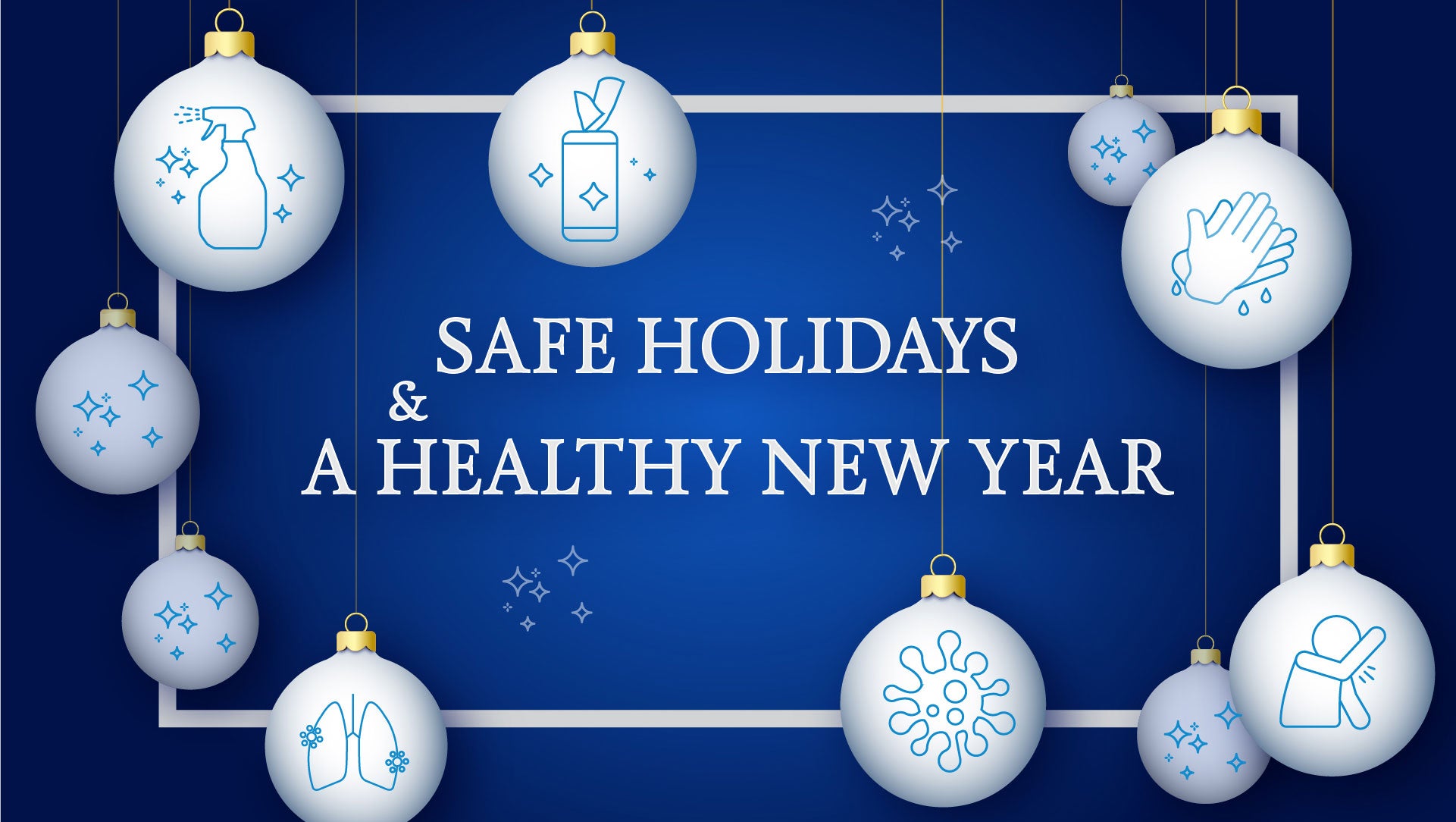
As winter decks the halls in holiday cheer, the season also brings the risk of respiratory infection. From the common cold to more serious threats like influenza and RSV, taking proactive measures to safeguard spaces against respiratory threats must be a top priority. Professional cleaners act as a first line of defense against illness for occupants, so their health and ability to clean and disinfect is critical. So, let's unwrap some strategies to help prevent the spread of respiratory viruses this winter and ensure we are prepared for what may come our way after we return from the holidays.
Cases of Respiratory Illness Are Trending in the Wrong Direction
Respiratory virus season has started a month early this year. The CDC estimates that there have already been at least 2.6 million illnesses.1 We do not usually see this many infections until late December. Nearly half of the country is seeing moderate to high levels of influenza-like illness, with that expected to grow in the coming months culminating to a later peak than last season.1 Increased illness will continue to place a significant burden on hospitals and clinics, healthcare workers, and vulnerable populations.
Don’t Overlook Factors Influencing Risk of Illness
As we move further into respiratory virus season, there are several factors that could increase illnesses. These include coming indoors for activities and gatherings, an uptick in holiday travel, and fewer people taking precautions like wearing masks.
When people spend more time indoors in close contact with others, the risk for germs to cause illness increases. Likewise, travel has the effect of moving germs from place to place and person to person. Global travel has increased by as much as 40% from 2022.2 This is evident as November 26 was the busiest day ever for air travel3 and 50% of adults say they plan to travel for the holidays.4 Additionally, prevention behaviors have mostly returned to pre-pandemic patterns with people taking fewer precautions to avoid spreading germs. According to a recent survey, half of adults say they do not plan on taking precautions to limit the spread of COVID-19 this winter.5 This is concerning because many respiratory viruses can result in severe disease and hospitalization. Currently, only 36% of adults have received the annual flu vaccine — the lowest flu vaccine uptake in the last 5 years.6
Implement Practical Tips to Safeguard Shared Spaces
For those managing public spaces, people's return from the holidays may mean an increased spread of respiratory viruses. To prepare, consider adopting the following strategies focused on preventing common illnesses by incorporating cleaning and disinfection best practices.
- Plan Ahead
- Establish well-defined roles and responsibilities for cleaning and disinfecting.
- Ensure both new and seasoned staff are provided with high-quality training like CloroxPro HealthyClean®.
- Identify high-touch surfaces where germs may lurk and plan to disinfect these surfaces regularly.
- Choose the Right Disinfectants
- Ensure disinfectant products are EPA-registered with efficacy claims against common winter germs including norovirus, influenza, and RSV.
- Use ready-to-use (RTU) products to efficiently tackle germ hot spots like classrooms, offices, and other common areas. RTU products are a more effective solution for fast and efficient disinfecting.
- Empower Occupants to Help
- Place signage to encourage hand washing, respiratory hygiene, and staying home when ill.
- Supply occupants with the necessary products, like disinfecting wipes, which are effective against respiratory viruses on personal and shared surfaces in as little as 15 seconds.
With an increase in respiratory illness, ensure you are prepared with products and protocols to meet the needs of the facilities you serve. As you plan for the holiday festivities, be sure that preventing respiratory illness makes it on your list, this is one thing you will absolutely want to check twice.
References
1. CDC. Weekly U.S. Influenza Surveillance Report - Key Updates for Week 48, ending December 2, 2023. [Internet. 2023 [cited 2023 Dec 8]. Available from: https://www.cdc.gov/flu/weekly/index.htm
2. Smialek J. America’s Foreign Vacations Tell Us Something About the U.S. Economy. The New York Times [Internet]. 2023 Jul 15 [cited 2023 Nov 28]; Available from: https://www.nytimes.com/2023/07/15/business/economy/inflation-travel-economy.html
3. Roeloffs MW. Sunday After Thanksgiving Was Busiest Day Ever for U.S. Airports—What It Could Mean for December’s Holiday Travelers [Internet]. Forbes. 2023 [cited 2023 Nov 29]. Available from: https://www.forbes.com/sites/maryroeloffs/2023/11/27/sunday-after-thanksgiving-was-busiest-day-ever-for-us-airports-what-it-could-mean-for-decembers-holiday-travelers/?sh=4167e0212eb9
4. El Issa E. 2023 Holiday Travel Report [Internet]. NerdWallet. 2023 [cited 2023 Nov 29]. Available from: https://www.nerdwallet.com/article/travel/2023-holiday-travel-report
5. Sparks G, Kirzinger A, Kearney A, Valdes I, Hamel L. KFF COVID-19 Vaccine Monitor November 2023: With COVID Concerns Lagging, Most People Have Not Gotten Latest Vaccine and Half Say They Are Not Taking Precautions This Holiday Season [Internet]. KFF. 2023 [cited 2023 Nov 29]. Available from: https://www.kff.org/coronavirus-covid-19/poll-finding/vaccine-monitor-november-2023-with-covid-concerns-lagging-most-people-have-not-gotten-latest-vaccine/
6. Influenza vaccine doses distributed, United States [Internet]. Cdc.gov. 2023 [cited 2023 Nov 27]. Available from: https://www.cdc.gov/flu/fluvaxview/dashboard/vaccination-doses-distributed.html

If it isn’t evident from the changing leaves, cooler temperatures, and kids busy back at school, Fall is upon us. The season’s change signals many things including cold and flu season. As people make their way indoors for more events and gatherings, the risk of spread of respiratory pathogens such as rhinovirus, influenza, RSV and COVID-19 increases. As we prepare for this respiratory virus season, let’s look back at how illness prevention has evolved.
Historical Cold and Flu Prevention Was Curious and Innovative
Having an annual respiratory illness season is not new. In fact, it is something that goes way back, beyond each of our lifetimes. Records have found mentions of influenza-like illness and spread as far back as 1,500 years ago.1 The popular belief of the time was that illness spread through miasma, which is unpleasant or unhealthy smelling air.2 Viruses that infect humans were not discovered until 19013 and shortly after, germ theory, the notion that certain diseases are caused by microorganisms in the body, took its place as the scientific theory for many infectious diseases.4
Before the discovery of viruses and adoption of germ theory, there was still a conscious effort to prevent the spread of illness. During the 17th century, physicians wore beaked masks, stuffed with aromatic herbs, and leather gloves to prevent plague. More modern prevention methods of the 19th century included gargling salt water daily,6 placing sliced onions around the home to “absorb” germs,7 and spraying an “anti-flu solution” into the air.6 While these prevention methods were curious and creative, they may not have been that effective. Other measures, like masking and isolation, were effective and continue to be used today.
As a result of advancement in modern science and understanding of disease, the past several decades have ushered in more effective ways to help combat the spread of pathogens.
Times Have Changed, So Has Our Ability to Fight Back
The COVID-19 pandemic brought with it uncertainty about seasonal patterns of respiratory illnesses these past few years. Regardless of what this coming cold and flu season may bring, we can rest assured knowing that today we have the education and resources necessary for prevention. Consider the following keys to success.
Identification: Know Your Enemy
Many of the respiratory illnesses that will be spreading this season have similar characteristics. Pathogens like rhinovirus, influenza, Respiratory Syncytial Virus (RSV) and COVID-19 cause similar symptoms and spread similarly through respiratory droplets. When someone ill coughs, sneezes, or talks, germs spread and many end up on nearby surfaces, where they can survive for weeks.8 Although these similarities exist, prevention may be different. Learn how to differentiate the epidemiology of common respiratory pathogens to ensure you have the correct prevention strategies in place.
Prevention: Attack on All Fronts
The rise of vaccines has played a critical role in protection against respiratory illness infection. Today, we have more options for immunization than ever, and this year we have access to an RSV vaccine and updated COVID-19 vaccines.9 Additionally, hand washing, respiratory etiquette, masking, and isolation when ill are proven strategies to prevent further illness spread. While each of these play an important role in prevention, environment focused actions like cleaning and disinfection, can help stop transmission from surfaces.
Many EPA-registered solutions can kill influenza and other common respiratory pathogens in as little as 15-seconds on common surfaces. Products that are ready-to-use — no need for dilution — also help to efficiently tackle high-touch surfaces and shared spaces by reducing labor and product costs. Likewise, established protocols and training allow for effective cleaning and disinfecting to occur. Both professional cleaners and building occupants play a vital role in helping to reduce surface spread of germs.
Although we no longer believe stinky air causes illness or that onions prevent the spread, one thing we can be sure of is that proper preparation and prevention can make all the difference in protecting spaces and helping to stop the spread of cold and flu this upcoming season.
References
1. Morens DM, North M, Taubenberger JK. Eyewitness accounts of the 1510 influenza pandemic in Europe. Lancet [Internet]. 2010;376(9756):1894–5. Available from: http://dx.doi.org/10.1016/s0140-6736(10)62204-0
2. Tulchinsky TH, Varavikova EA, Cohen MJ. A history of public health. In: The New Public Health. Elsevier; 2023. p. 1–54.
3. Mirza AZ, Shamshad H, Osra FA, Habeebullah TM, Morad M. An overview of viruses discovered over the last decades and drug development for the current pandemic. Eur J Pharmacol [Internet]. 2021 [cited 2023 Sep 18];890(173746):173746. Available from: http://dx.doi.org/10.1016/j.ejphar.2020.173746
4. Germ theory [Internet]. Contagion - CURIOSity Digital Collections. [cited 2023 Sep 19]. Available from: https://curiosity.lib.harvard.edu/contagion/feature/germ-theory
5. Conti AA. Protective face masks through centuries, from XVII century plague doctors to current health care professionals managing the COVID-19 pandemic. Acta Biomed [Internet]. 2020 [cited 2023 Sep 19];91(4):e2020124–e2020124. Available from: https://www.mattioli1885journals.com/index.php/actabiomedica/article/view/10231
6. Little B. Photos: Innovative ways people tried to protect themselves from the flu [Internet]. HISTORY. 2020 [cited 2023 Sep 18]. Available from: https://www.history.com/news/flu-masks-protection-photos
7. LaBianca J. 9 crazy old-time remedies that were used to treat the flu [Internet]. Reader’s Digest. 2018 [cited 2023 Sep 18]. Available from: https://www.rd.com/list/crazy-old-time-flu-remedies/
8. Wißmann, J. E, et al. (2021). Persistence of pathogens on inanimate surfaces: A narrative review. Microorganisms, 9(2), 343.
9. Looking ahead at COVID, flu, and RSV vaccines for fall 2023 [Internet]. Johns Hopkins Bloomberg School of Public Health. 2023 [cited 2023 Sep 19]. Available from: https://publichealth.jhu.edu/2023/looking-ahead-at-covid-flu-and-rsv-vaccines-for-fall-2023
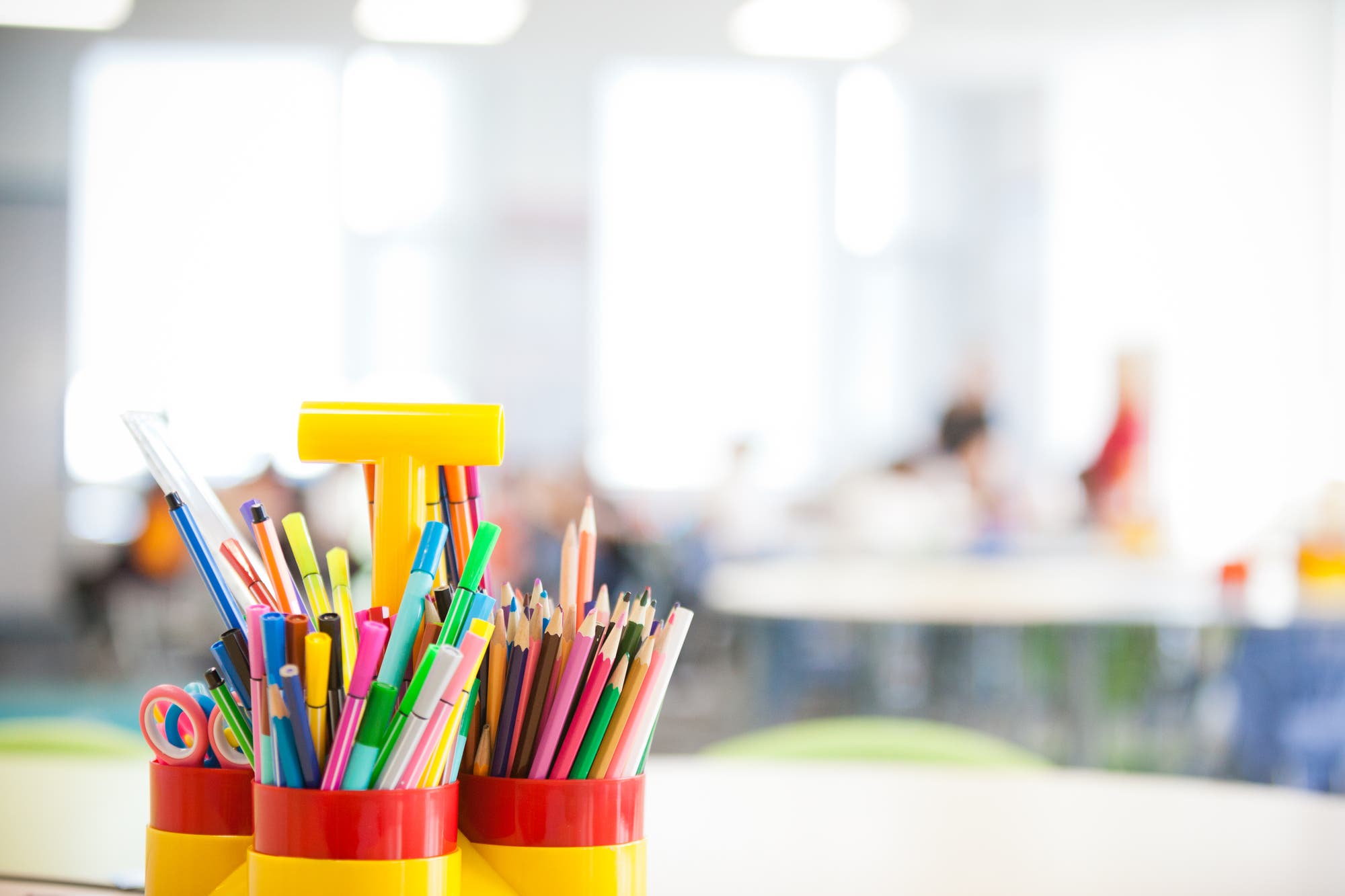
With summer quickly slipping away, now is the time to consider the “just right” cleaning and disinfection solutions to prepare for a new school year. You may recall the classic children's fairy tale of Goldilocks and the Three Bears about a curious girl who enters the house of three bears while they're away, sampling their food and belongings and causing mischief. In the story, some of the items she sampled were not to her satisfaction while others were “just right.” This blog describes a Goldilocks approach to cleaning and disinfection while providing recommendations for maintaining health and safety in K–12 schools.
Just Right Products
Just as Goldilocks discovered not all items were equal, cleaning and disinfection products have differences including efficacy, compatibility, and application. This makes identifying the right products for the job essential for success as you plan for back-to-school cleaning operations. No matter what space you are cleaning, having the right products will contribute to a more effective and efficient process. Consider the following examples of cleaning and disinfectant product types to be used and have on hand.
- Cleaners: Use a versatile product for your everyday job cleaner. These tend to be concentrated, cost-effective, compatible with many surfaces, and work on different types of soils and stains.
- Disinfectants: Germs tend to follow students, so be prepared with an EPA-registered disinfectant product with efficacy claims against common germs including norovirus, influenza, and RSV that can survive on surfaces for several weeks.1 In the case of an outbreak of illness, ensure there is a sufficient supply of disinfecting products to combat any spread in your facility.
- Restroom Solutions: Look for products that are tough on stains and proven to combat odors and human soils such as blood, urine, feces and vomit.
- Special Tasks: For tough jobs such as mold and mildew remediation and for removal of grease and soap scum, use products designed for and effective at handling that specific task.
Just Right Spaces
Prior to school getting back in session, it is important to ensure that the right products are being paired with the right spaces. Consider performing an assessment of your school facility to understand where the risks are and which spaces will need the most attention. Hot spots for germs and other messes often include high traffic areas such as restrooms, classrooms, hallways, locker rooms, and gyms. Disinfectant wipes and spray products work well on frequently touched surfaces in these areas to effectively remove germs and other dirt.
Just Right Training
When it comes to cleaning and disinfection, products are only as effective as those using them. Staff should be properly trained and have up-to-date protocols which provide clear direction for cleaning and disinfection activities in schools. Don’t forget one of your biggest helpers in classroom cleaning is the teachers. It is important that teachers be provided with disinfectant products to help keep their classroom clean. We recently did a study of classroom disinfecting and found that all the desks in a classroom could be treated with disinfecting wipes in as little as 3 minutes.2 This not only shows the ability for efficient classroom cleaning to take place, but enables teachers to perform more frequent cleaning, helping to keep a cleaner and safer facility throughout the day.
By identifying products, ensuring adequate supply, evaluating spaces, and engaging with trained cleaning staff and teachers, school facilities can be prepared for back to school and like Goldilocks, rest well knowing that everything is “just right.”
References
1. Wißmann, J. E, et al. (2021). Persistence of pathogens on inanimate surfaces: A narrative review. Microorganisms, 9(2), 343.
2. CloroxPro. Time in Motion Study 2.0 RTU Sprays and Wipes. 2023.

Routine and deep cleaning are part of the overall health and safety of a facility and the people who enter it. In this blog, we will focus on deep cleaning in schools and explore what deep cleaning is, when to perform it, and what resources are available to help cleaning professionals.
In many ways, deep cleaning is like car maintenance: if you do regular checks and some deeper cleaning tasks regularly, you can often prevent bigger issues from arising. If you have ever driven a vehicle and seen the check engine light suddenly come on, you may have wondered what was going on and how it could have been avoided. To improve health and safety in schools, deep cleaning practices are essential. With foot traffic decreasing and schools moving at a slower pace during the summer months, it's the perfect time to deep clean areas of the building to maintain a healthier facility.
Deep Cleaning Goes Beyond Routine Cleaning and Disinfection Tasks
Using car maintenance as an analogy, routine cleaning is like a drive through car wash or an oil change. Deep cleaning is more thorough and does not need to be done as frequently, like changing a car’s transmission fluid. These types of tasks are more detailed and time-intensive, focusing on larger spaces and areas that may be difficult to access regularly. In a facility, deep cleaning enhances appearance and eliminates germs, mold, dust, and other potentially harmful matter that can accumulate over time. As an example, you may frequently take out the trash, but it’s also important to clean and disinfect the receptacles too.
K-12 Schools Need a Deep Clean
As a place where children spend much of their time, K-12 facilities must prioritize deep cleaning for health and safety. When deep cleaning protocols aren’t in place, surfaces may be overlooked during routine cleaning. An example of this is window glass where harmful germs can survive for up to 12 weeks1. Like germs causing illness, exposure to indoor allergens and irritants like dust, mold, and mildew can result in missed days of school each year2. To ensure that schools are adequately cleaned and prepared for students, now is the time to establish deep cleaning practices if they are not already in place.
Tuning Up Your Cleaning Practices
To establish an effective and efficient deep cleaning program in your facility, consider the following steps:
- Conduct a facility assessment: Determine areas of your facility that may be difficult to clean regularly. When was the last time your facility’s supply closet was thoroughly cleaned, for example?
- Develop a deep cleaning schedule: Unlike routine cleaning, deep cleaning is needed periodically (monthly, quarterly, semi-annually, etc.). Determine at what frequency your facility’s deep cleaning tasks should be completed.
- Establish protocols: Create or adopt standardized deep cleaning processes that provide specific guidance on how to perform tasks safely and efficiently. Staff members should be trained and able to complete tasks to the required standard. A helpful resource to guide you through the deep cleaning process is the CloroxPro® Deep Cleaning Protocol Sheet.
- Identify necessary tools and products: Consider what products and equipment are required for the job. For example, if you are cleaning trash receptacles, use a ready-to-use broad-spectrum disinfectant. Ensure all supplies are available for a successful deep cleaning and don’t forget personal protective equipment (PPE).
- Document the time needed for deep cleaning: Consider documenting how long each task takes to help with planning for this work to be effective and efficient in the future. Keep in mind that certain tasks may require moving furniture or items which could require extra time.
As we enter the end of the school year, planning your deep cleaning schedule will help set you up for success as you smoothly cruise into a new school year, like a vehicle just outfitted with new tires.
References
- Wißmann, J. E, et al. (2021). Persistence of pathogens on inanimate surfaces: A narrative review. Microorganisms, 9(2), 343.
- EPA. Managing Asthma in the School Environment [Internet]. [cited 2023 May 1]. Available from: https://www.epa.gov/iaq-schools/managing-asthma-school-environment
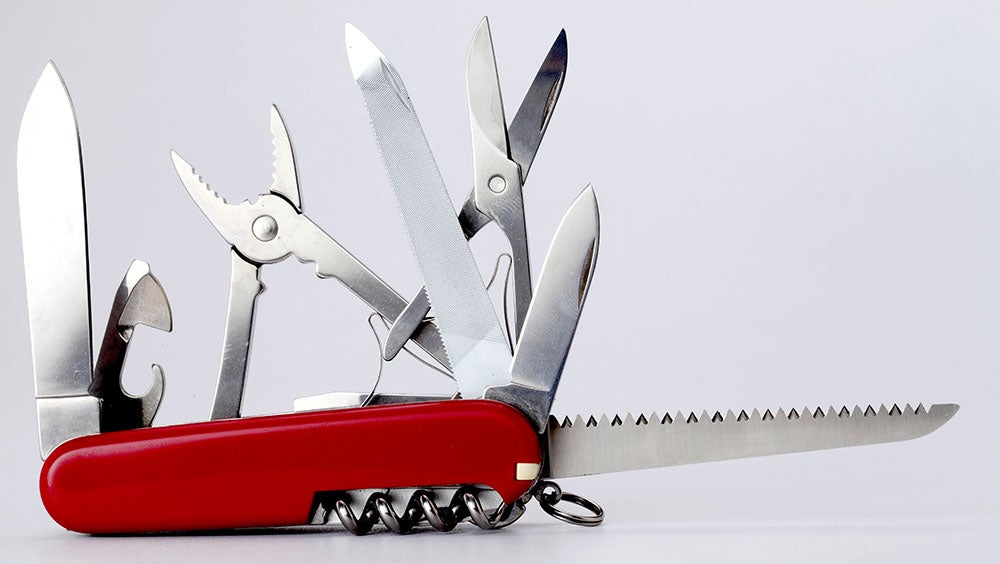
As an outdoor enthusiast, one item I rarely go without on my adventures is my Swiss Army Knife. This trusty little pocketknife has come in handy and gotten me out of a pickle more than once. With a dozen differing tools, its functionality provides a simple and convenient solution to various small tasks. Whether on the trail, making camp, or at home, the Swiss Army Knife’s versatility has become something I can rely on to get the job done.
A versatile cleaner can perform a similar “Swiss Army Knife” function by offering convenience and efficiency in your day-to-day cleaning operations. Let’s explore how.
What is a versatile cleaner?
A versatile cleaner is your anywhere, everywhere, every job cleaner. These tend to be concentrated, cost-effective, compatible with many surfaces, and work on different types of soils and stains. They may also be a solution to a cluttered cart and simplify a complicated work process. These features make versatile cleaners a powerful tool for cleaning operations, offering convenience and efficiency.
Implement a versatile cleaner in a janitorial operation
A versatile cleaner can reduce or eliminate the need for many cleaning products. The CDC recommends minimizing the number of different environmental cleaning products in use at a facility.1 Fewer cleaning products mean a more simplified cleaning process, reduced training requirements for staff, and less potential for errors in preparation and use. A versatile cleaner adds efficiency to cleaning operations by saving staff time and allowing them to better focus on their tasks. With versatile cleaners used in various settings and applications, there is opportunity to work these into existing processes. Consider which of your current tasks can be completed by using the same versatile cleaner and make the shift to a more efficient solution.
What features should I look for in a versatile cleaner?
Not all cleaning products are created equal. In general, you should look for a versatile cleaner that has the following features:
- Concentrated. This is a cleaner you will use frequently, so a concentrate is a must-have to help you save money and storage space.
- Compatible with a broad range of surfaces. A cleaner compatible with various surface materials (i.e., wood, sealed granite, laminate, vinyl, stainless steel) is necessary to tackle your routine tasks and prevent damage.
- Combats multiple types of soils. For best results, cleaners should break down the toughest soils to remove dirt, soap scum, grease, rust, hard water stains and more.
- BONUS: Is a broad-spectrum disinfectant. To combat the spread of viruses and bacteria, determine if the product is an EPA-registered disinfectant, and what pathogen efficacy claims are available. Follow directions for use for application and dwell time.
Remember, when looking for ways to simplify and add efficiency to your cleaning operation, adopt the “Swiss Army Knife” approach and use a versatile cleaner for your facility’s needs.
References
1. Centers for Disease Control and Prevention. Environmental cleaning supplies and equipment [Internet]. [cited 2023 Mar 10]. Available from: https://www.cdc.gov/hai/prevent/resource-limited/supplies-equipment.html
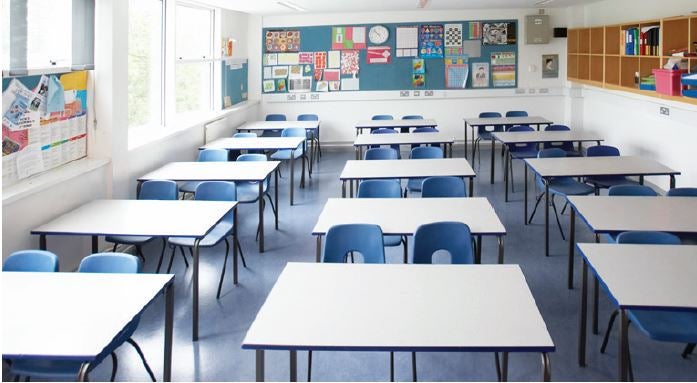
This winter holiday season was a time of festivities, recreation, and family, however it unfortunately also brought with it severe weather, disrupted travel plans, and a potential spread of illness. During a season of giving, germs were the one gift that no one wanted but likely received. Hopefully, the new year is off to a promising start with resolutions and good luck and not a new cough and cold.
New Year, New update on Cold and Flu
As much of the country has experienced high levels of cold and flu, the recent state of respiratory season has begun to look more optimistic. Illness levels have been declining for several weeks1 and RSV cases peaked in December2. The holiday season, usually followed by an increase in influenza-like illness (ILI), may mean an increase in sickness with the return to work and school.
With most schools opting to continue with only minimal prevention measures in place3, we shouldn’t be surprised at a slight uptick in sickness over the next several weeks. As respiratory pathogens like influenza, RSV, and rhinovirus remain circulating, it continues to be necessary to take steps to help protect against these illness-causing germs into the winter months.
While School’s In, Keep Germs Out
Surfaces contaminated from a cough or sneeze or touched with dirty hands can allow germs to spread to others and can even result in illness. Children’s busy hands can touch and retouch over 300 surfaces in as little as 30 minutes4. An easy way to help reduce the number of germs that spread in schools is through surface cleaning and disinfection.
A 2022 Clean Index study by CloroxPro found that out of 12 public spaces ranked for cleanliness, schools ranked 6th falling in the bottom half below restaurants and grocery stores5. Additionally, 1 in 3 Americans said they felt more comfortable going into schools before the pandemic5. The reality is that schools that aren’t clean are at increased risk for illness. School administrators with cleaning professionals have a responsibility to ensure school buildings and classrooms are kept healthy and safe.
To help schools slow the spread of illness, the CDC recommends the following considerations for cleaning and disinfection6:
1. Remove germs the right way. Understand the difference between cleaning, disinfecting, and sanitizing. Be mindful of what occasions and where each of these practices should be employed.
| Cleaning | Sanitization | Disinfection | |
| Definition | Physical removal of dirt, debris, and some germs from surfaces by scrubbing or wiping. | Lowers the number of germs on surfaces to a safe level by killing bacteria. | Kills or inactivates germs (bacteria and viruses) on surfaces or objects. |
| Application | Sweeping floors, dusting, and cleaning horizontal surfaces and countertops with cleaning product or soap and water. | Most often applicable in food service preparation areas. | Disinfect shared, frequently touched surfaces in high-traffic areas including classrooms, hallways, and bathrooms. |
2. Establish and follow procedures. Focus cleaning and disinfecting efforts on high touch surfaces and objects like desks, countertops and doorknobs. Follow the school’s set guidance on frequency and areas of focus.
3. Don’t overthink it. Routine cleaning and disinfection activities are sufficient when matched to the types of germs you want to remove or kill. During times of high disease transmission or an outbreak, rely on routine procedures instead of closing school or doing extra cleaning and disinfecting to help slow the spread of germs.
4. Use the right product in the right way. Review and follow cleaning and disinfectant product labels to ensure effectiveness against common germs such as influenza, rhinovirus and RSV. Allow surfaces to remain wet for the required time to kill germs. Be conscious about type of surface or object being cleaned and proceed according to the directions for use.
5. Make safety a priority. Anyone who uses cleaners and disinfectants should understand all instruction labels for safe and appropriate use. Heed hazard warnings, product directions, and PPE requirements before beginning. Avoid using disinfecting products near children while school is in session. Teachers and staff should wash hands after using or handling products. Additional instructional material and training should be available to staff as needed.
For guidance on daily and after-hours cleaning and disinfection for K–12 educational facilities, review the Environmental Cleaning & Disinfection Protocol Guide.
References
1. CDC. Weekly U.S. Influenza Surveillance Report [Internet]. [cited 2023 Jan 11]. Available from: https://www.cdc.gov/flu/weekly/index.htm
2. CDC. RSV National Trends – NREVSS [Internet]. [cited 2023 Jan 11]. Available from: https://www.cdc.gov/surveillance/nrevss/rsv/natl-trend.html
3. Kinsa Insights- Illness Report. Kinsa Illness Update: Week of Jan 1, 2023. [cited 2023 Jan 10].
4. Gerba, C. P. The Burden of Norovirus in Schools; Cengage Learning, 2016
5. CloroxPro. 2022 Clean Index Study. Data for this report was collected in an April 2022 online survey of a nationally representative U.S. General Population based on age, gender, region, race/ethnicity and income and cleaning industry professionals defined as business service contractors, facility managers in education, office buildings, medical facilities or gyms or infection preventionists.
6. CDC. How To Clean and Disinfect Schools To Help Slow the Spread of Flu [Internet]. [cited 2023 Jan 11]. Available from: https://www.cdc.gov/flu/school/cleaning.htm
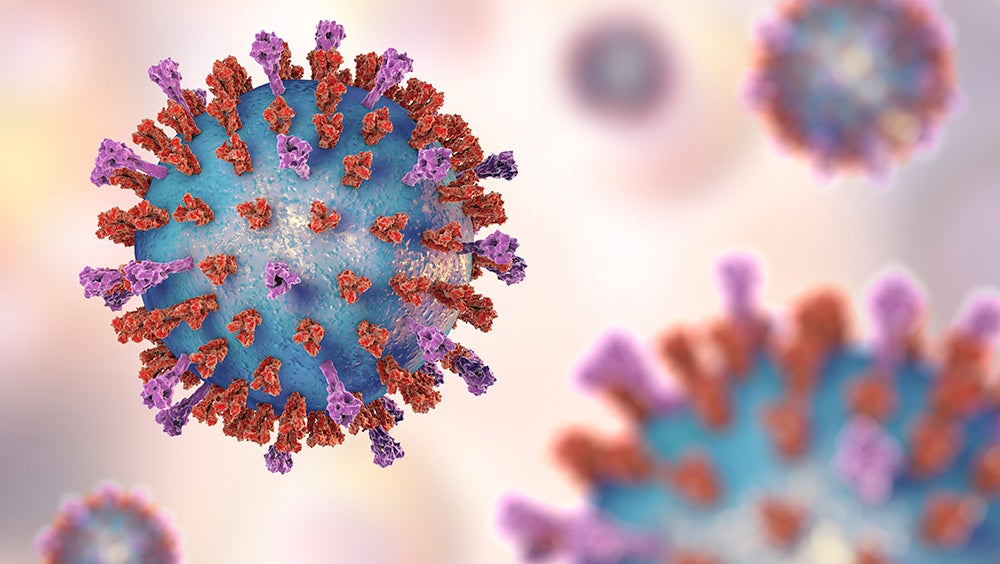
As reports of circulating respiratory pathogens have entered the news and media outlets, everyone is on high alert. One pathogen that is getting attention is respiratory syncytial (sin-SISH-uhl) virus, also known as RSV. RSV is recognized as one of the most common causes of childhood illness. With a recent increase in cases, many hospitals, especially pediatric units, are expressing concern as they near capacity.1 The good news is there are ways to slow the spread of illness causing germs and protect the health and safety of our communities. Continue reading to find out more about RSV and learn about strategies and tools to help.
History and Epidemiology
RSV was discovered in 1956 in a group of chimpanzees and wasn’t recognized as a pathogen primarily infecting humans until later.2 As one of the most widely recognized causes of seasonal illness, RSV is responsible for millions of respiratory infections in the U.S. each year.3
RSV typically causes mild, cold-like symptoms including runny nose, decreased appetite, coughing, sneezing, fever, and wheezing. These symptoms usually begin 4-6 days after infection and occur in stages rather than all at once.4 Most people fully recover in 1-2 weeks. RSV infections can be serious, especially for infants and older adults. In the U.S., RSV is the most common cause of bronchiolitis and pneumonia in children younger than one and a significant cause of respiratory illness in older adults.5 Annually, RSV infections in the U.S. are attributed to 58,000 hospitalizations among children younger than five years old and 177,000 hospitalizations among adults aged 65 years or older.3
RSV usually circulates in the U.S. during fall, winter, and spring months, but the timing and severity of RSV has been unpredictable over the past few years. Due to pandemic restrictions, RSV nearly disappeared during the 2020–2021 respiratory season only to surge out-of-season during the summer of 2021. This year, RSV case numbers increased earlier than expected. It is unclear when, or if, the predictable seasonal spreading of RSV will return.3
Preventing the Spread
RSV is spread by droplets when an infected person coughs or sneezes, or by surfaces if someone touches a contaminated surface and then touches their face before washing their hands. RSV is known to survive for many hours on hard surfaces and objects, which is a risk of transmission and exposure. Survival on soft surfaces like tissues and hands is more limited.6
Currently, no RSV vaccine is available. In the absence of a vaccine, the CDC recommends four things to help stop the spread of RSV this respiratory season:7
- Cover coughs and sneezes. Use your elbow or a tissue and not your hands, which are more likely to spread virus through touch.
- Wash hands. Carefully and frequently wash hands with soap and water or use an alcohol-based hand sanitizer.
- Stay home when ill. Encourage those who are sick to stay home and limit contact with others.
- Clean and disinfect. Ensure frequent cleaning and disinfecting of high-touch and contaminated surfaces and objects with an EPA-registered disinfectant.
Tools to help keep spaces safe
In addition to personal care, there is a shared responsibility in maintaining the health and safety of the environments where learning, work, and play occur. With RSV and respiratory illness on the rise, many excellent tools and resources are available to assist facilities in helping keep spaces clean and disinfected. For example, disinfecting wipes are easy-to-use and an excellent tool to use throughout the day in shared spaces and high traffic areas. The CloroxPro RSV Pathogen Education Sheet provides additional information about RSV and products that are EPA registered to be effective against this virus. To learn about other seasonal respiratory pathogens, and see a side-by-side comparison, take a look at the CloroxPro Respiratory Pathogens resource.
References
1. Romo V. Children's hospitals grapple with a nationwide surge in RSV infections [Internet]. NPR. NPR; 2022 [cited 2022 Oct 28]. Available from: https://www.npr.org/2022/10/24/1130764314/childrens-hospitals-rsv-surge
2. Junge S, Nokes DJ, Simões EAF, Weber MW. Respiratory Syncytial Virus [Internet]. International Encyclopedia of Public Health. Academic Press; 2008 [cited 2022 Oct 28]. Available from: https://www.sciencedirect.com/science/article/pii/B9780123739605006213
3. CDC. RSV Trends and Surveillance [Internet]. [cited 2022 Oct 28]. Available from: https://www.cdc.gov/rsv/research/us-surveillance.html
4. CDC. RSV Symptoms. [Internet]. [cited 2022 Oct 28]. Available from https://www.cdc.gov/rsv/about/symptoms.html
5. CDC. Respiratory Syncytial Virus Infection (RSV). [Internet]. [cited 2022 Oct 28]. Available from https://www.cdc.gov/rsv/index.html
6. CDC. RSV Transmission. [Internet]. [cited 2022 Oct 28]. Available from https://www.cdc.gov/rsv/about/transmission.html
7. CDC. RSV Prevention. [Internet]. [cited 2022 Oct 28]. Available from https://www.cdc.gov/rsv/about/prevention.html
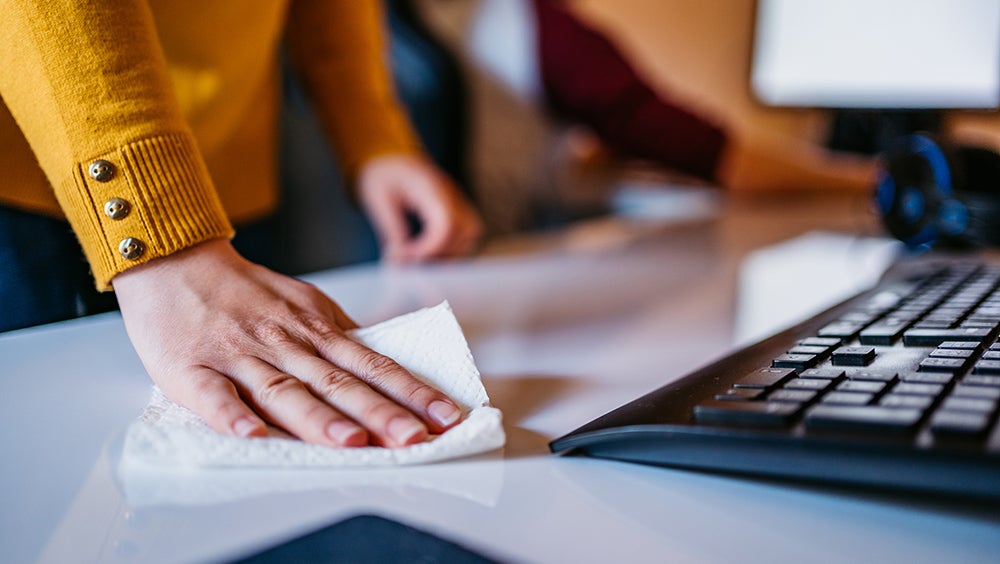
Office occupancy rates are the highest since the beginning of the pandemic
While the pandemic closed some doors it also opened others with new opportunities for virtual and hybrid work. Many have enjoyed a change of scenery but there are still companies and employees eager to get back to the office. Recent office occupancy data show an increasing number of employees are returning to some form of in-person work. In October, the average weekly office occupancy rate in 10 top U.S. metro areas reached 49%, the highest since the beginning of the pandemic.1 In other states, this rate is seen to be as high as 65%.1
As more people return to office buildings, there is a need for facilities to adopt a holistic infection prevention strategy that includes cleaning and disinfecting to help reduce the spread of germs that can cause illness. Not only is having spaces cleaned and regularly disinfected a best practice, but it has become the expectation of office workers. CloroxPro’s 2022 Clean Index study found that one-third of respondents (34%) were more comfortable going into the office prior to the pandemic.2 Additionally, 74% of office workers said they would feel most safe by regularly seeing janitors and cleaning staff at their place of work.2 Help safeguard office spaces and promote a healthy work environment with ready-to-use disinfecting wipes, a tool both office workers (65%) and cleaning professionals (70%) agree is most effective in keeping spaces cleaned and disinfected.2
When and how to win with wipes in the office
Disinfecting wipes are a simple and effective way to maintain the cleanliness of spaces while getting rid of germs like cold and flu that can live on surfaces for hours up to weeks.3 To maximize the impact of disinfecting wipes, consider implementing the following recommendations in office spaces:
- During the workday. Wipes are a powerful tool when used daily to disinfect frequently touched surfaces.
- For Cleaning Staff: Focus on using disinfecting wipes in common and shared spaces like conference and break rooms. These areas should be wiped between uses and after high-use periods. Surfaces like light switches, doorknobs, and counters in hallways and other high-traffic areas should also be regularly disinfected.
- For Building Occupants: Empower building occupants to keep personal workspaces and shared areas clean by making disinfecting wipes available. CloroxPro’s study revealed that 65% of office workers state they have disinfected an office, conference room, desk, or other public use item at work.2 This demonstrates their willingness to help keep places they go clean. Access to wipes in a facility encourages regular disinfection behavior and makes occupants feel safest.2
- When there are raised levels of illness. Protect shared office spaces and occupants during outbreaks and times when illness levels typically spike, like during cold and flu season, by having day cleaning staff use wipes to disinfect shared, high-touch surfaces. Consider contacting your local health department to determine illness levels in your community.
- For thorough and complete coverage. Use an “S” movement when wiping surfaces. Be sure to follow the contact time listed on the product label, allowing surfaces to remain wet for the required time to effectively kill pathogens. Use multiple wipes if necessary to achieve the required wetness.
- To avoid cross-contamination. Always start with cleaner surfaces first and then move to dirtier areas. Change and dispose of used wipes often, especially when moving from one area to another.
One size doesn’t fit all
It is important to think about all cleaning and disinfection product options and have a well-rounded supply of tools for an effective process. In addition to wipes, use other supplies like spray bottles, pull-tops, or dilutable solutions when appropriate. For example, spray products are a great option for disinfecting commonly touched surfaces in restrooms.
Popular no-touch disinfection technologies like electrostatic sprayers may also add a layer of depth to cleaning and disinfection protocols. Electrostatic sprayers are considered easy to use and allow for more thorough cleaning and disinfection when the resources to manually clean and disinfect are limited. A recent study found electrostatic sprayers to add cleaning efficiency by covering more space and up to 4x faster than manual disinfection, while still being just as effective.4
The key to reducing the spread of germs in offices and shared spaces is in selecting the right product to fit the need and then executing with excellence. Consider how your protocols can be updated to incorporate these strategies while integrating ready-to-use solutions, such as wipes, into your everyday process.
References
1. Kastle Systems. Kastle Back to Work Barometer 10.17.22 - Weekly Occupancy Report from Kastle Access Control System Data [Internet]. Kastle Systems - Data Assisting in Return to Office Plans. 2022 [cited 2022Oct19]. Available from: https://www.kastle.com/safety-wellness/getting-america-back-to-work/#workplace-barometer
2. CloroxPro. 2022 Clean Index Study. Data for this report was collected in an April 2022 online survey of a nationally representative U.S. General Population based on age, gender, region, race/ethnicity and income and cleaning industry professionals defined as business service contractors, facility managers in education, office buildings, medical facilities or gyms or infection preventionists.
3. Wißmann, J. E, et al. (2021). Persistence of pathogens on inanimate surfaces: A narrative review. Microorganisms, 9(2), 343.
4. Cadnum JL, Jencson AL, Livingston SH, Li D, Redmond SN, Pearlmutter B, et al. Evaluation of an Electrostatic Spray Disinfectant Technology for Rapid Decontamination of Portable Equipment and Large Open Areas in the Era of SARS-CoV-2. Am J Infect Control [Internet]. 2020; Available from: https://doi.org/10.1016/j.ajic.2020.06.002